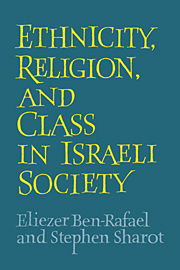Book contents
- Frontmatter
- Contents
- Acknowledgments
- I Theoretical and empirical background
- II Social patterns and behavior
- III Identities and images
- 8 Ethnic consciousness
- 9 Class consciousness
- 10 Religious, ethnic, and class divisions: convergent or crosscutting?
- IV The impact of stratification
- V Social cleavages: an overview of Israeli society and some theoretical implications
- Appendix A The sample
- Appendix B Deprivation index
- Appendix C Indexes of ethnic identification
- Glossary
- Notes
- References
- Index
10 - Religious, ethnic, and class divisions: convergent or crosscutting?
Published online by Cambridge University Press: 12 September 2009
- Frontmatter
- Contents
- Acknowledgments
- I Theoretical and empirical background
- II Social patterns and behavior
- III Identities and images
- 8 Ethnic consciousness
- 9 Class consciousness
- 10 Religious, ethnic, and class divisions: convergent or crosscutting?
- IV The impact of stratification
- V Social cleavages: an overview of Israeli society and some theoretical implications
- Appendix A The sample
- Appendix B Deprivation index
- Appendix C Indexes of ethnic identification
- Glossary
- Notes
- References
- Index
Summary
A religious-secular division
The Arab-Jewish division is an ubiquitous issue for Israelis, but with respect to divisions within the Jewish population, the focus of public attention appears to have moved in recent years from the ethnic division between Jews of European and African or Asian origins to the division between “religious” and “secular” Jews. The mass media has reported numerous conflicts, some involving violent confrontations, between religious and secular Jews over such issues as public transport on the Sabbath, the opening of cinemas on the Sabbath eve, the burning of bus stations displaying advertisements featuring women in swimming costumes or underwear, the free movement of private transport in areas close to religious neighborhoods on the Sabbath, the freedom of archaeologists to excavate ancient sites which may have included Jewish cemeteries, the legitimacy of conversions to Judaism under non-Orthodox auspices, and the question of “who is a Jew.” It is true that it has been haredim (ultra-Orthodox) rather than “modern Orthodox” Jews who have been involved in these conflicts, but a number of observers have argued that there is a trend within the religious population toward “/zaraiization” and that the Jewish population is becoming increasingly polarized with respect to religion.
A sociological analysis of the religious-secular division or conflict in Israel should not only examine its extensiveness and intensity, but also its relationships with other divisions, particularly ethnic and class divisions.
- Type
- Chapter
- Information
- Ethnicity, Religion and Class in Israeli Society , pp. 155 - 174Publisher: Cambridge University PressPrint publication year: 1991



